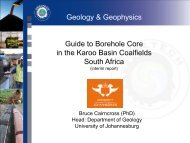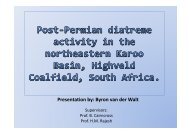coaltech upper olifants river catchment wetland inventory ...
coaltech upper olifants river catchment wetland inventory ...
coaltech upper olifants river catchment wetland inventory ...
You also want an ePaper? Increase the reach of your titles
YUMPU automatically turns print PDFs into web optimized ePapers that Google loves.
More important in the removal of metals is the role played by algae. Algae are manganese<br />
accumulators and can accumulate other metals as well. The metal uptake ability of algae is<br />
controlled by the specific bioaccumulation and physical-chemical factors present. Although<br />
algae can accumulate vast amounts of metals in relation to mass, the distribution of algae in<br />
<strong>wetland</strong>s is limited and therefore the total metal uptake by algae in the <strong>wetland</strong>. The most<br />
important role of plants in the removal of metals from the system are therefore not in the<br />
accumulation of metals, but in changing the environment to that more suitable for the<br />
removal of toxicants (Palmer et al 2002, Kotze 2000, Kotze et al 2000).<br />
Acid mine drainage has entered the Kromdraaispruit <strong>wetland</strong> (located approximately 20 km<br />
north-west of Witbank) for 20 years, a <strong>wetland</strong> with distinct morphological zones. The<br />
Kromdraaispruit <strong>wetland</strong> is located in the Kromdraaispruit, a tributary of the Zaalklapspruit,<br />
flowing into the Wilge River. Vegetation in the <strong>wetland</strong> removes high percentages of influent<br />
metals. The accumulation of iron and manganese takes place in the roots and aerial parts<br />
(stems and leaves) of the <strong>wetland</strong> vegetation (Limpitlaw 1995). It was determined that the<br />
biochemical water quality of acid mine drainage passing through a <strong>wetland</strong> improves with<br />
distance moved through the <strong>wetland</strong>. It was also determined that the concentration of<br />
sulphate-reducing bacteria increases with distance away from the pollution source (Limpitlaw<br />
1996). The immobilisation of metals was best in the areas of optimal organic adsorption of<br />
metals (Limpitlaw 1995, 1996).<br />
Permanently wet seeps can function to reduce nitrate, sulphate, iron and manganese. Where<br />
there are both nitrates and sulphates in the groundwater competition occurs for the available<br />
carbon and reduction is therefore a slower process. Similar processes occur in the seasonal<br />
seeps, but the leaching of immobilised substances can occur before soil saturation, thereby<br />
affecting changes to the redox potential and pH of the site. Organic materials in the <strong>wetland</strong><br />
are lost when the water levels drop (Palmer et al 2002).<br />
Wetland Database for UORC - 37 -




